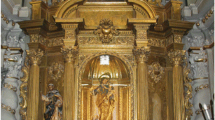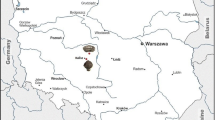Abstract
The voltammetry of microparticles (VIMP) methodology was applied to a set of submicrosamples from the corrosion layers of copper artifacts from the archaeological site of La Vital (Gandia, Spain), dated back to 4200 to 3900 BP, attached to graphite electrodes in contact with aqueous acetate buffer at pH 4.50. Signals for the reduction of cuprite plus malachite, dominating the composition of the corrosion layers, and tenorite, were used for grouping the samples. A model to describe their relative concentrations assuming gradients following a potential law is proposed and tested with experimental data. Correlation of VIMP sample grouping with lead isotope data in literature permitted to discriminate archaeological samples depending on the provenance of raw materials and the manufacturing process.









Similar content being viewed by others
References
Radivojevic M, Rehren T, Pernicka E, Silvar D, Brauns M, Boric D (2010) On the origin of extractive metallurgy: new evidence from Europe. J Archaeol Sci 37:2775–2787
Sessa C, Bagán H, Romero MT, García JF (2017) Effects of variability sources on analysis of the composition of large ancient metal objects. Microchem J 134:309–316
Constantinides I, Gritsch M, Adriaens A, Hutter H, Adams F (2001) Microstructural characterisation of five simulated archaeological copper alloys using light microscopy, scanning electron microscopy, energy dispersive X-ray microanalysis and secondary ion mass spectrometry. Anal Chim Acta 440:189–198
Shalev S, Shilstein SS, Yekutieli Y (2006) XRF study of archaeological and metallurgical material from an ancient copper-smelting site near Ein-Yahav, Israel. Talanta 70:909–913
Gaudiuso R, Dell’Aglio M, De Pascale O, Loperfido S, Mangone A, De Giacomo A (2014) Laser-induced breakdown spectroscopy of archaeological findings with calibration-free inverse method: comparison with classical laser-induced breakdown spectroscopy and conventional techniques. Anal Chim Acta 813:15–24
del Hoyo-Meléndez JM, Swit P, Matosz M, Wozniak M, Klisinska-Topacz A, Bratasz L (2015) Micro-XRF analysis of silver coins from medieval Poland. Nucl Inst Methods Phys Res B 349:6–16
Gale NH, Stos-Gale ZA, Maliotis G, Annetts N (1997) Lead isotope data from the isotrace laboratory, Oxford: Archaeometry data base 4, ores from Cyprus. Archaeometry 39:237–246
Attanasio D, Bultrini G, Ingo GM (2001) The possibility of provenancing a series of bronze punic coins found at Tharros (Western Sardinia) using the literature lead isotope database. Archaeometry 43:529–547
Resano M, Marzo MP, Alloza R, Saénz C, Vanhaecke F, Yang L, Willie S, Sturgeon RE (2010) Laser ablation single-collector inductively coupled plasma mass spectrometry for lead isotopic analysis to investigate evolution of the Bilbilis mint. Anal Chim Acta 677:55–63
Gomes SS, Monge Soares A, Araujo MF, Correia VH (2016) Lead isotopes and elemental composition of Roman fistulae plumbeae aquariae from Conimbriga (Portugal) using Quadrupole ICP-MS. Microchem J 129:184–193
Klein S, Lahaye Y, Brey GP (2004) The Early Roman Imperial AES coinage II: tracing the copper sources by analysis of lead and copper isotopes-copper coins of Augustus and Tiberius. Archaeometry 46:469–480
Balliana E, Aramendía M, Resano M, Barbante C, Vanhaecke F (2013) Copper and tin isotopic analysis of ancient bronzes for archaeological investigation: development and validation of a suitable analytical methodology. Anal Bioanal Chem 405:2973–2986
Scott DA (1994) An examination of the patina and corrosion morphology of some Roman bronzes. J Am Ite Cons 33:1–23
Robbiola L, Blengino J-M, Fiaud C (1998) Morphology and mechanisms of formation of natural patinas on archaeological CuSn alloys. Corros Sci 40:2083–2111
Agresti J, Osticioli I, Guidotti MC, Kardjilov N, Siano S (2016) Non-invasive archaeometallurgical approach to the investigations of bronze figurines using neutron, laser, and X-ray techniques. Microchem J 124:765–774
Robbiola L, Portier R (2006) A global approach to the authentication of ancient bronzes based on the characterization of the alloy–patina–environment system. J Cult Herit 7:1–12
Chiavari C, Rahmouni K, Takenouti H, Joiret S, Vermaut P, Robbiola L (2007) Composition and electrochemical properties of natural patinas of outdoor bronze monuments. Electrochim Acta 52:7760–7769
Scholz F, Meyer B (1998) Voltammetry of solid microparticles immobilized on electrode surfaces. In: Bard AJ, Rubinstein I (eds) Electroanalytical chemistry, a series of advances, vol 20. Marcel Dekker, New York, pp 1–86
Scholz F, Schröder U, Gulabowski R, Doménech-Carbó A (2014) Electrochemistry of immobilized particles and droplets, 2nd. Springer, Berlin-Heidelberg
Doménech-Carbó A, Labuda J, Scholz F (2013) Electroanalytical chemistry for the analysis of solids: characterization and classification (IUPAC Technical Report). Pure Appl Chem 85:609–631
Costa V, Leyssens K, Adriaens A, Richard N, Scholz F (2010) Electrochemistry reveals archaeological materials. J Solid State Electrochem 14:449–451
Arjmand F, Adriaens A (2012) Electrochemical quantification of copper-based alloys using voltammetry of microparticles: optimization of the experimental conditions. J Solid State Electrochem 16:535–543
Serghini-Idrissi M, Bernard MC, Harrif FZ, Joiret S, Rahmouni K, Srhiri A, Takenouti H, Vivier V, Ziani M (2005) Electrochemical and spectroscopic characterizations of patinas formed on an archaeological bronze coin. Electrochim Acta 50:4699–4709
Doménech-Carbó A, Doménech-Carbó MT, Martínez-Lázaro I (2008) Electrochemical identification of bronze corrosion products in archaeological artifacts, a case study. Microchim Acta 162:351–359
Satovic D, Martinez S, Bobrowski A (2010) Electrochemical identification of corrosion products on historical and archaeological bronzes using the voltammetry of micro-particles attached to a carbon paste electrode. Talanta 81:1760–1765
Doménech-Carbó A, Doménech-Carbó MT, Costa V (2009) In: Scholz F (ed) Electrochemical methods in archaeometry, conservation and restoration, Monographs in Electrochemistry Series. Springer, Berlin-Heidelberg
Doménech-Carbó A (2010) Voltammetric methods applied to identification, speciation and quantification of analytes from works of art: an overview. J Solid State Electrochem 14:363–379
Doménech-Carbó A, Doménech-Carbó MT (2018) Electroanalytical techniques in archaeological and art conservation. Pure Appl Chem 90:447–462
Doménech-Carbó A (2017) Electrochemical dating: a review. J Solid State Electrochem 21:1987–1998
Capelo S, Homem PM, Cavalheiro J, Fonseca ITE (2013) Linear sweep voltammetry: a cheap and powerful technique for the identification of the silver tarnish layer constituent. J Solid State Electrochem 17:223–234
Cepriá G, Abadías O, Pérez-Arantegui J, Castillo JR (2001) Electrochemical behavior of silver-copper alloys in voltammetry of microparticles: a simple method for screening purposes. Electroanalysis 13:477–483
Doménech-Carbó A, Del Hoyo-Menéndez J, Doménech-Carbó MT, Piquero-Cilla J (2017) Electrochemical analysis of the first Polish coins using the voltammetry of immobilized particles. Microchem J 130:47–55
Di Turo F, Montoya N, Piquero-Cilla J, De Vito C, Coletti F, Favero G, Doménech-Carbó A (2017) Archaeometric analysis of Roman bronze coins from the Magna Mater temple using solid-state voltammetry and electrochemical impedance spectroscopy. Anal Chim Acta 955:36–47
Doménech-Carbó A, Doménech-Carbó MT, Montagna E, Lee Y (2017) Electrochemical discrimination of mints: the last Chinese emperors Kuang Hsü and Hsüan T’ung monetary unification. Talanta 169:50–56
Doménech-Carbó A, Doménech-Carbó MT, Álvarez-Romero C, Montoya N, Pasíes-Oviedo T, Buendía M (2017) Electrochemical characterization of coinage techniques the 17th century: the maravedís case. Electroanalysis 29:2008–2018
Di Turo F, Montoya N, Piquero-Cilla J, De Vito C, Coletti F, Favero G, Doménech-Carbó MT, Doménech-Carbó A (2018) Dating archaeological strata in the Magna Mater Temple using solid-state voltammetric analysis of leaded bronze coins. Electroanalysis 30:361–370
Doménech-Carbó A, Doménech-Carbó M T, Capelo S, Pasíes-Oviedo T, Martínez-Lázaro I (2014) Dating archaeological copper/bronze artifacts using the voltammetry of microparticles. Angew Chem Int Ed 53:9262–9266
Doménech-Carbó A, Doménech-Carbó MT, Redondo-Marugán J, Osete-Cortina L, Barrio J, Fuentes A, Vivancos-Ramón MV, Al-Sekhaneh W, Martínez B, Martínez-Lázaro I, Pasíes-Oviedo T (2018) Electrochemical characterization and dating of archeological leaded bronze objects using the voltammetry of immobilized particles. Archaeometry 60:308–324
Doménech-Carbó A, Doménech-Carbó MT, Peiró-Ronda MA (2011) Dating archaeological lead artifacts from measurement of the corrosion content using the voltammetry of microparticles. Anal Chem 83:5639–5644
Ferragud-Adam X, Piquero-Cilla J, Doménech-Carbó MT, Guerola-Blay V, Company X, Doménech-Carbó A (2017) Electrochemical analysis of gildings in Valencia Altarpieces: a cross-age study since 15th until 20th century. J Solid State Electrochem 21:1477–1487
Martínez B, Piquero-Cilla J, Montoya N, Doménech-Carbó MT, Doménech-Carbó A (2018) Electrochemical analysis of gold embroidery threads from archaeological textiles. J Solid State Electrochem 22:2205–2215
Doménech-Carbó A, Scholz F, Doménech-Carbó MT, Piquero-Cilla J, Monytoya N, Pasíes-Oviedo T, Gozalbes M, Melchor-Montserrat JM, Oliver A (2018) Dating of archaeological gold by means of solid state electrochemistry. ChemElectroChem 5:2113–2117
Doménech-Carbó A, Scholz F (2019) Electrochemical age determinations of metallic specimens – the utilization of the corrosion clock. Acc Chem Res 52:400–406
Doménech-Carbó A, Doménech-Carbó MT, Peiró-Ronda MA, Martinez-Lázaro I, Barrio J (2012) Application of the voltammetry of microparticles for dating archaeological lead using polarization curves and electrochemical impedance spectroscopy. J Solid State Electrochem 16:2349–2356
Doménech-Carbó A, Lastras M, Rodríguez F, Cano E, Piquero-Cilla J, Osete-Cortina L (2014) Monitoring stabilizing procedures of archaeological iron using electrochemical impedance spectroscopy. J Solid State Electrochem 18:399–409
Di Turo F, Parra R, Piquero-Cilla J, Favero G, Doménech-Carbó A (2019) Crossing VIMP and EIS for studying heterogeneous sets of copper/bronze coins. J Solid State Electrochem 23:771–781
Rovira S, Montero-Ruiz E (2011) Aspectos metalúrgicos, in Pérez-Jordá G, Bernabeu-Aubán J, Carrión-Marco Y, García-Puchol O, Molina-Balaguer L, Gómez-Puche M, La Vital (Gandia, Valencia): vida y muerte en la desembocadura del Serpis durante el III y el I milenio a.C. Museo de Prehistoria de Valencia, Valencia, pp. 219-227
Díaz-Castillo A (2011) El marco cronológico a partir de la evidencia radiocarbónica del yacimiento de La Vital, in Pérez-Jordá G, Bernabeu-Aubán J, Carrión-Marco Y, García-Puchol O, Molina-Balaguer L, Gómez-Puche M, Eds. La Vital (Gandia, Valencia): vida y muerte en la desembocadura del Serpis durante el III y el I milenio a.C. Museo de Prehistoria de Valencia, Valencia, pp. 235-245
Budd P, Gale D, Pollard AM, Thomas RG, Williams PA (1993) Evaluating lead isotope data: further observations. Archaeometry 35:241–247
Budd P, Pollard AM, Scaiffe B, Thomas RG (1995) The possible fractionation of lead isotopes in ancient metallurgical processes. Archaeometry 37:143–150
Baron S, Le-Carlier C, Carignan J, Ploquin A (200) Archaeological reconstruction of medieval lead production: implications for ancient metal provenance studies and paleopollution tracing by Pb isotopes. Appl Geochem 24:2093–2101
Burgio L, Clark RJH (2001) Library of FT-Raman spectra of pigments, minerals, pigment media and varnishes, and supplement to existing library of Raman spectra of pigments with visible excitation. Spectrochim Acta A 57:1491–1521
Caggiani MC, Cosentino A, Mangone A (2016) Pigments Checker version 3.0, a handy set for conservation scientists: a free online Raman spectra database. Microchem J 129:123–132
Stos-Gale Z, Gale NH, Houghton J, Speakman R (1995) Lead isotope data from the isotrace laboratory, Oxford: Archaeometry data base 1, ores from the Western Mediterranean. Archaeometry 37:407–415
Kuleff I, Iliev I, Pernicka E, Gergova D (2006) Chemical and lead isotope compositions of lead artifacts from ancient Thracia (Bulgaria). J Cult Herit 7:244–256
Doménech-Carbó A, Doménech-Carbó MT, Redondo-Marugán J, Osete-Cortina L, Vivancos-Ramón MV (2016) Electrochemical characterization of corrosion products in leaded bronze sculptures considering ohmic drop effects on Tafel analysis. Electroanalysis 28:833–845
Scott DA (1997) Copper compounds in metals and colorants: oxides and hydroxides. Stud Conserv 42:93–100
Funding
This study received financial support from the project CTQ2017-85317-C2-1-P, supported with Ministerio de Economía, Industria y Competitividad (MINECO), Fondo Europeo de Desarrollo Regional (ERDF), and Agencia Estatal de Investigación (AEI).
Author information
Authors and Affiliations
Corresponding authors
Additional information
Publisher’s note
Springer Nature remains neutral with regard to jurisdictional claims in published maps and institutional affiliations.
Electronic supplementary material
ESM 1
(DOC 51 kb)
Rights and permissions
About this article
Cite this article
Doménech-Carbó, A., Bernabeu-Aubán, J. Correlation between lead isotope analysis and solid-state electrochemistry for determining the provenance of archaeological bronze. J Solid State Electrochem 23, 2803–2812 (2019). https://doi.org/10.1007/s10008-019-04378-3
Received:
Revised:
Accepted:
Published:
Issue Date:
DOI: https://doi.org/10.1007/s10008-019-04378-3




